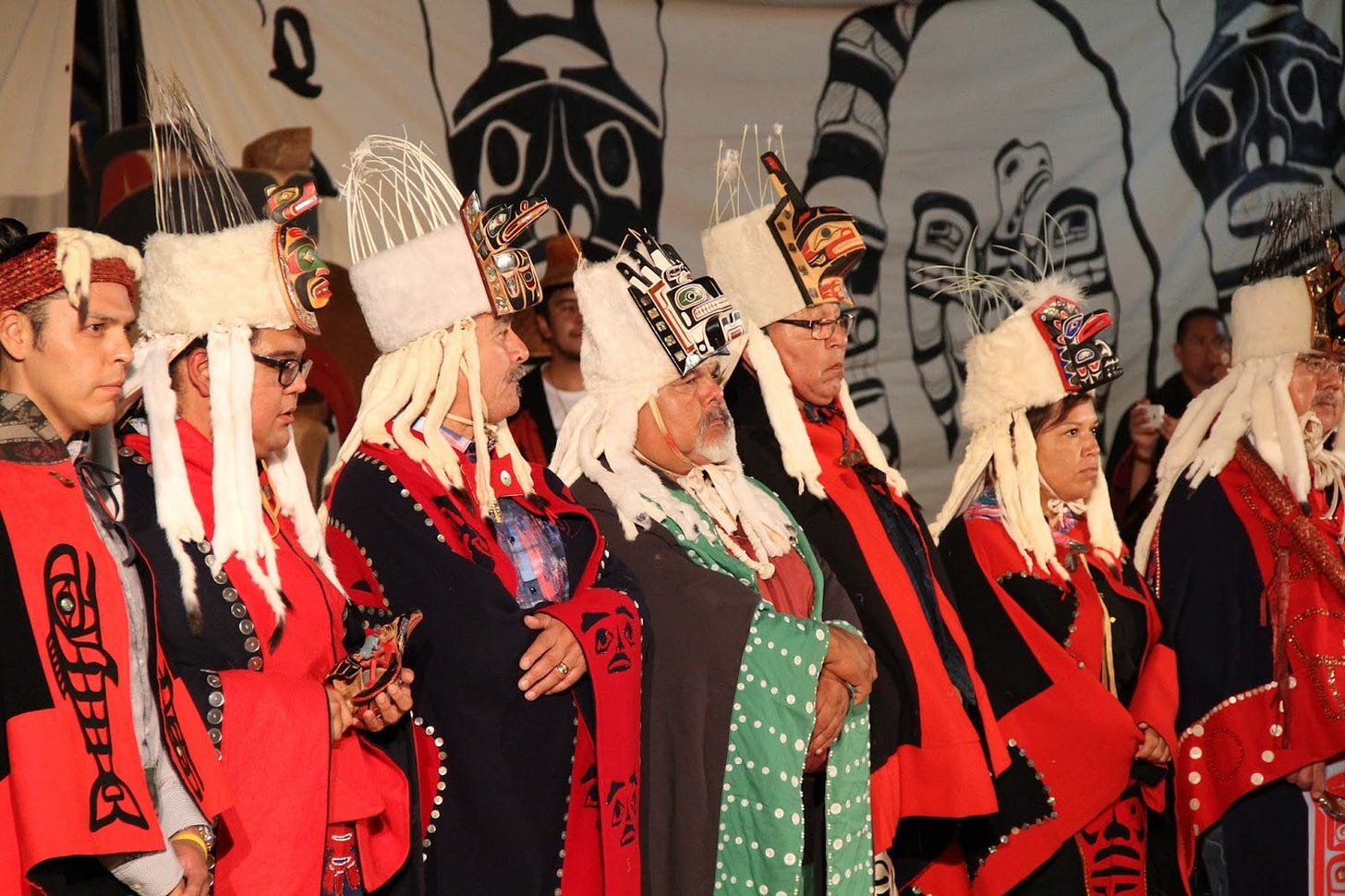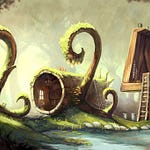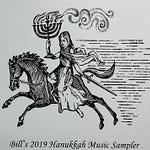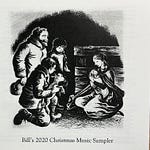The songs
'Namgis Paddling and Entrance songs are two traditional songs of the 'Namgis sub-group of the Kwakwa̱ka̱ʼwakw First Nation (also known as the Kwakiutl.) The ‘Namgis originate from the Gwani or Nimpkish River on the Northern tip of Vancouver Island but are now based in Alert Bay on Cormorant Island, near Port Hardy. The Kwakwa̱ka̱ʼwakw are the larger and more well-known language group that is south of the Heiltsuk traditional territory.
The Paddling Song’s rhythm was used to coordinate the paddlers of giant cedar dugout canoes. The slow, steady tempo of the song matches the pace of the job. The Entrance Song was sung by the families from their canoes when they arrived at potlatches or other gatherings. In the Coastal Native tradition, the rights to sing certain songs are owned by individuals or communities. The Entrance Song is shared by the 'Namgis with their Mowachaht (Nuu chah nulth) neighbors from the West Coast of Vancouver Island, who are of a different language group.
The recordings were made in 2002 by the ‘Namgis singers for the CD album Laxwe'gila – Gaining Strength to support a five-day gathering by that name in Alert Bay. The gathering included a 3-day camping experience where workshops on traditional uses of plants, traditional food preparation and preservation, and cedar basket weaving were taught, and there were traditional sharing circles for people of all ages. There was also a day of canoeing, and the gathering concluded with a large community feast.
The Enemy Came as a Wolf This is a traditional celebration song of the Mandan and Hidatsa people. They were peaceful, hospitable tribes who dwelt on the upper reaches of the Missouri River. This song was collected from Scattered Corn in 1912 by Frances Densmore. She was one of the first ethnomusicologists to do field recording, using an Edison wax cylinder home phonograph.
This song was likely heard by the Lewis and Clark Corps of Discovery who wintered with the Mandan in 1804-05. The weather was particularly harsh that winter but the Mandan Chief Sheheke had assured the explorers: "If we eat, you shall eat." It is sung here by Nellie Youpee and Ruth Short Bull, recorded for the above album in 1999.
Essay: My reminiscence of attending Hereditary Chief Chester Lawson’s Potlatch in Bella Bella

[Note: If before reading this reminiscence you want to know more about what a potlach is and why they are important to the Heiltsuk people you can read this background essay I wrote about them, and about why potlatches were banned in Canada for 70 years.]
In the winter of 1990/91 I was the Policy Analyst for the British Columbia Heritage Conservation Branch. There were two main roles for that Branch; supporting local governments in the protection of built heritage, almost entirely built by non-Native settlers from the time after colonization, and managing the automatic protection of pre-colonial indigenous archaeological sites. (I use the word colonial literally – Vancouver Island and British Columbia were once British colonies.)
Because my main role as Policy Analyst was developing improved overall legislation, other than the Executive Director and administrative staff I was the only person whose role involved both sides of the Branch. By preference, I regularly had my coffee breaks with the archaeologists, their admin support person, and a woman named Kim Lawson. She was a recent Anthropology graduate, and a member of the Heiltsuk First Nation. As I recall, she was hired by our Branch in a temporarily capacity to liaise with the Education Ministry to develop an educational unit for high schools about how information about the past can be learned through the discipline of Archaeology, and explaining how archaeological sites in BC were protected and managed.
One day in November or December at coffee break she told us that her father was inviting us to come for a weekend in January to Bella Bella to attend her father’s potlatch. Bella Bella is an unincorporated “Indian reserve” community that has a population of about 1000 people. It is one of the most remote communities in BC, on an Island on the rugged central coast about equidistant from northern tip of Vancouver Island and the port town of Prince Rupert.
Her father is Chester Lawson. The purpose of the potlatch was to validate and celebrate his assumption to the title of being one of the Heiltsuk people’s hereditary chiefs.
I had read about potlatches: They are closed ceremonies that usually only members from the community and invited witnesses from other neighbouring tribes can attend. I was thrilled at the invitation and immediately told her I wanted to come. I was very surprised that only one of the archeologists and none of the Branch managers took her up on her father’s offer. Because so few were coming I asked Kim if one of my daughters could come along to experience this rare opportunity. She said she would ask her father but was confident that the answer would be yes.
I had expected to take my older daughter Gillian, who was 11 years old at the time, but the trip would have involved taking a Friday and Monday off school; she had a conflicting test and her mother did not want her to miss it. So eight year old Wendy got to go.
It turns out that this wasn’t just an opportunity to attend the potlatch. We brought our sleeping bags and billeted with Chester and his wife Deana in their home. We got to see the run-up and the afterglow from inside the family’s perspective!
The trip began very early on the Friday morning with an 500 km (300 mile) drive to Port Hardy on the northern tip of the Island. About 1/3 of that was on a gravel logging road. We all road together in one car. Then there was about a 1½ hour flight in a de Havilland Otter bush seaplane to get to Bella Bella. The trip was very bumpy. I clutched the barf bag the whole way and was very happy when we landed without having had to use it.
Chester and Deana met us at the dock and we walked to their home. In fact, the town is small enough that I saw very few cars being driven there; everybody walks in the middle of the street.
As planned, we had arrived just in time to drop off our sleeping bags and backpacks at their house and go to the Friday evening gathering of the key people who were involved in the organization and presentation of the event. At the party there was the usual meeting of so many people whose names I couldn’t remember, and I was still pretty queasy from the flight.
One striking memory from that party was meeting teenagers who were going to be the dancers, drummers and singers. I think they appreciated the rare opportunity to chat with someone who was from outside their own community and their culture. They answered my naïve questions about what to expect at the potlach.
I was especially impressed by the focused young man who was going to dance the sacred Hamat’sa; the core ritual of the occasion. While everyone else was drinking soda pop and munching on the food, he only drank water. He told me that he had never danced the Hamat’sa before and that he considered it to be a great honour that Chester had bestowed on him, and a great responsibility. He had been fasting and ritually bathing early every day in a particular stream for the past month. You can click on the following image for a 2:00 video that I found on YouTube about the intertribal Hamat’sa society.
The next day, Chester and Deanna’s home was a busy place. Some elders who lived on an outlying island had come to town for the occasion. The museum director came to interview them regarding the details of their genealogies. If I remember correctly, they only spoke Haíɫzaqvḷa, the Heiltsuk language. The museum director told me that the sisters were an invaluable source for both the language itself and Heiltsuk oral history and she interviewed them whenever they came to town.
Many people stopped by briefly to contribute money to Chester for the potlatch. Chester immediately recorded everything in his little notebook. At one point Chester got a very disappointing phone call. It was from his brother who lived on the mainland. He was not going to be able to come.
One thing that I hadn’t thought about at the time, but realized later, was that at the party the evening before and throughout the day there was no consulting with Chester about last-minute glitches. Either his support team was dealing with everything themselves, or the event was very well planned. I suspect it was both.
In late afternoon we walked to the Bella Bella School gym for the potlatch. I think it was the biggest room in the town at the time. Chester was the school`s principal. Since he was a Haíɫzaqvḷa speaker and tradition bearer himself, he ensured that the curriculum encouraged the students to love and maintain their traditional culture. That might explain why the dancers, drummers and singers were mostly teenagers.
The room was set up with the gym bleachers pulled out, chairs for the elders at one end, trestle tables for serving the food and sitting down at the other end, and an open space in the middle. Kim suggested that we sit with her on the top row of the bleachers, facing the open area. She said that was her favourite spot for getting a good overview of the pageantry, and she was right.
As people arrived so did the food, and both the gym and the two long serving tables filled up. It never occurred to me to count how many people attended, and since this all happened over 30 years ago now I don’t trust my memory. My best guess would be about 250 people.
The food table looked from a distance like a potluck dinner, but Kim said that her father had commissioned elders and others in the community to make the food, just as he had commissioned local crafters and artists to make many of the items that would be given away.
Then the potlach began. First was the feast, and I do mean feast. First to serve themselves were the hereditary chiefs. Then elders and invited guests were called to come get their food first. Kim said that included us. What? Wendy and I were equivalent to elders in the hierarchy of attendees? Yes.
The tables were filled with large portions. Some things I recognized as familiar; casseroles, salads, side dishes and desserts. There was lots of different kinds of seafood, especially salmon cooked in various ways.
Some foods I didn’t recognize, like 50 mm (2”) rectangles of sticky little spheres with a black line down the middle. One of the elder ladies that was next to me in line told me they were processed herring eggs still stuck onto kelp leaves. They are a highly prized delicacy in Japan, and are the community’s most distinctive and its most important seafood product. You can watch this video (3½ minutes) to learn more about the Heiltsuk roe-on-kelp fishery.
At the end of the table the elder ladies’ eyes lit up when they saw big bowls of what looked a bit like globby butter. Oolichan grease, a rare delicacy! I had heard of that in the context of “grease trails” that went over the coastal mountain range. The first nations people had traditionally travelled those trails to trade the rich oolichan grease from the coast for goods from the interior that they didn’t have locally, such as obsidian, a naturally occurring volcanic glass that made very sharp cutting tools.
The elders ladled dollops of oolichan grease on their plates, pushing aside other things to make room for it, and lathered it on their salmon. I took about a heaping teaspoon full. I knew I was in trouble when I saw the mischievous twinkle in their eyes when they invited me and Wendy to come and sit with them at the table.
They ate their oolichan grease first thing. I think the expression on my face when I first tried a bit of mine lived up to their expectations. It would be quite an understatement to say that I didn’t care for the taste, texture or smell. Then they told me that it would be bad manners to leave any on the plate. The twinkles had turned to big grins. I did eat it all and the old ladies said that they were quite impressed by that. As I look back on it now, I am quite proud to have eaten this heritage food. Perhaps due to climate change, large oolichan runs are getting very rare now.
After the feast came the gift-giving, speeches (some in Haíɫzaqvḷa and some in English), and ceremonial dances. The gifts seemed just keep coming and coming. Most families were given plastic laundry baskets to carry their gifts home; many of them were useful household items, and some were hand-crafted items ranging from crocheted pot-holders to silver bracelets. A lot of the children were thrilled when they got watches. Elders got wool blankets. Invited guests were called to the center of the cleared area to be given envelopes with cash. This included me and Wendy. Since none of the other recipients said publicly how much their cash gifts were I’ll stay silent as well. I suppose that it is safe for me to acknowledge that it seemed quite generous.
All I can say about the dances is that they were spectacular. By that time I was getting pretty overwhelmed by the whole thing. Some had many dancers wearing blanket-capes with totem insignia outlined by mother-of-pearl buttons, elaborate headdresses, and other traditional regalia items. A couple of them wore woven long-fringed Chillcoot blankets (possibly quite old.)
This article about a bigger 5-day ceremony held to celebrate the recent opening of new big house in Bella Bella includes a 4:40 video showing glimpses of the types of regalia worn.
Other dances had only one or two participants and had special meaning. In those the dancers wore wooden masks. I remember in one of the dances there were two frog masks. We were told that the masks belong a Haida Hereditary Chief. He couldn’t come himself but by sending his masks and his dance he was bearing witness to Chester’s claim to hereditary chieftainship.
There were also masked dances from the nearby Nuxhalk First Nation on the mainland. Another dance featured a very long-beaked bird mask. It belonged to a Kwakwakaʼwakw (also called Kwakiutl) Hereditary Chief. Those masks were there for the same reason. And of course, there was the sacred Hamat’sa in which the dancer did not wear regalia but began as the wild man from the forest.
After the potlatch was over, Chester, Deana and all of the rest of us were too buzzed to go home, so we went for a long walk under the bright stars in the quiet streets of the town. While we were walking I told Chester that much of what had happened that I did not understand, and asked him what responsibilities I had assumed as an invited guest and as a recipient of a cash gift. He said that as a non-Heiltsuk I was not expected to understand everything. My only responsibility was to remember what I could, and to tell people about what I remember having seen.
So, I saw Chester Lawson give a potlatch at which he claimed the title of Hereditary Chief. There were many people there and no one disputed his claim to the title. I hope that by this account I have lived up to the great honour he bestowed upon me when he invited me to come to his potlatch.
[Note: Now that you have read this reminiscence if you want to know more about what potlaches mean as part of the Heiltsuk culture you can still read the side-essay about them, and about why for 70 years they were banned in Canada.]

















Share this post